Identification of a Novel Prognostic Signature Based on N-Linked Glycosylation and Its Correlation with Immunotherapy Response in Hepatocellular Carcinoma
- PMID: 37841372
- PMCID: PMC10575065
- DOI: 10.2147/JHC.S417407
Identification of a Novel Prognostic Signature Based on N-Linked Glycosylation and Its Correlation with Immunotherapy Response in Hepatocellular Carcinoma
Abstract
Background: The complex tumor microenvironment of hepatocellular carcinoma (HCC) has led to a low response to immune checkpoints inhibitors (ICIs) and a poor prognosis. PD-L1, as one of the indications for ICIs, is rich in glycosylation modifications, which result in untimely ICIs. Our study constructed a prognostic model based on N-linked glycosylation related genes for predicting the prognosis and the response to ICIs.
Methods: The list of N-linked glycosylation related genes is from the AmiGO2 database. The patients in The Cancer Genome Atlas (TCGA) and Gene Expression Omnibus (GEO) cohorts were enrolled. The Cox regression was performed to develop a prognostic model and patients were divided into a low- and high-risk subgroups. The role of signature in HCC was well investigated by prognostic analysis, gene set enrichment analysis, and immune infiltration analysis. 21 recurrent HCC patients who received postoperative adjuvant ICIs were recruited to evaluate the relationship between immunotherapy response and the signature. In vitro studies were conducted to investigate the oncogenic effects of DDOST, STT3A and TMEM165 in HCC.
Results: 59 N-linked glycosylation related differentially expressed genes were screened from HCC and normal tissues in the TCGA cohort. The prognostic model was developed with DDOST, STT3A and TMEM165. The risk score could be an independent prognostic factor. Patients in the high-risk subgroup showed a worse prognosis than patients in the low-risk one. ssGSEA showed that patients in the low-risk subgroup tended to be in the immune-activated state, with higher levels of B cell and macrophage cell infiltrations and lower levels of regulatory T cell (Treg) infiltrations in both TCGC and GEO cohorts. Immunohistochemistry studies showed that DDOST, STT3A and TMEM165 are highly expressed in tumor tissues and patients with a high-risk score correlated with poor progression free survival and worse immunotherapeutic response. Furthermore, the proliferation of HCC cells was reduced after the knockdown of DDOST, as well as upon the knockdown of STT3A and TMEM165.
Conclusion: In this study, we establish that the risk model based on N-linked glycosylation related genes could efficiently predict the prognosis and tumor microenvironment immune state of HCC patients, and the risk score could serve as a novel indicator of immunotherapy.
Keywords: HCC; N-linked glycosylation; immune infiltration; immunotherapy; prognostic signature.
© 2023 Lin et al.
Conflict of interest statement
The authors declare that they have no conflicts of interest in this work.
Figures
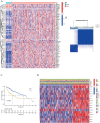
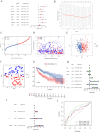
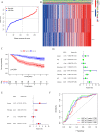
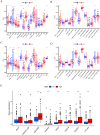
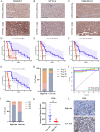
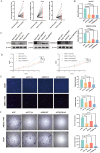
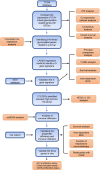
Similar articles
-
Comprehensive analysis of immune-related gene signature based on ssGSEA algorithms in the prognosis and immune landscape of hepatocellular carcinoma.Front Genet. 2022 Dec 9;13:1064432. doi: 10.3389/fgene.2022.1064432. eCollection 2022. Front Genet. 2022. PMID: 36568383 Free PMC article.
-
Identification of the Tumor Immune Microenvironment and Therapeutic Biomarkers by a Novel Molecular Subtype Based on Aging-Related Genes in Hepatocellular Carcinoma.Front Surg. 2022 Mar 22;9:836080. doi: 10.3389/fsurg.2022.836080. eCollection 2022. Front Surg. 2022. PMID: 35392063 Free PMC article.
-
Identification of a prognostic and therapeutic immune signature associated with hepatocellular carcinoma.Cancer Cell Int. 2021 Feb 10;21(1):98. doi: 10.1186/s12935-021-01792-4. Cancer Cell Int. 2021. PMID: 33568167 Free PMC article.
-
Characterizing the key genes of COVID-19 that regulate tumor immune microenvironment and prognosis in hepatocellular carcinoma.Funct Integr Genomics. 2023 Aug 4;23(3):262. doi: 10.1007/s10142-023-01184-z. Funct Integr Genomics. 2023. PMID: 37540264
-
Signature construction and molecular subtype identification based on cuproptosis-related genes to predict the prognosis and immune activity of patients with hepatocellular carcinoma.Front Immunol. 2022 Sep 28;13:990790. doi: 10.3389/fimmu.2022.990790. eCollection 2022. Front Immunol. 2022. PMID: 36248822 Free PMC article.
Cited by
-
Integrated multi-omics analysis and machine learning refine molecular subtypes and prognosis in hepatocellular carcinoma through O-linked glycosylation genes.Funct Integr Genomics. 2025 Jul 28;25(1):162. doi: 10.1007/s10142-025-01669-z. Funct Integr Genomics. 2025. PMID: 40719796
-
Application of a risk score model based on glycosylation-related genes in the prognosis and treatment of patients with low-grade glioma.Front Immunol. 2024 Oct 9;15:1467858. doi: 10.3389/fimmu.2024.1467858. eCollection 2024. Front Immunol. 2024. PMID: 39445005 Free PMC article.
-
DDOST is associated with tumor immunosuppressive microenvironment in cervical cancer.Discov Oncol. 2024 Mar 9;15(1):69. doi: 10.1007/s12672-024-00927-z. Discov Oncol. 2024. PMID: 38460058 Free PMC article.
-
The liquid-liquid phase separation signature predicts the prognosis and immunotherapy response in hepatocellular carcinoma.J Cell Mol Med. 2024 Jul;28(14):e18446. doi: 10.1111/jcmm.18446. J Cell Mol Med. 2024. PMID: 39072983 Free PMC article.
References
LinkOut - more resources
Full Text Sources
Research Materials
Miscellaneous

